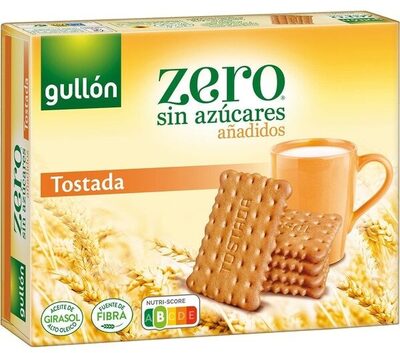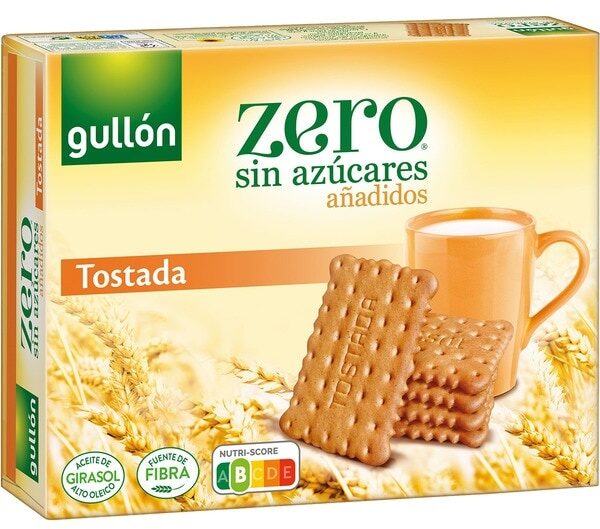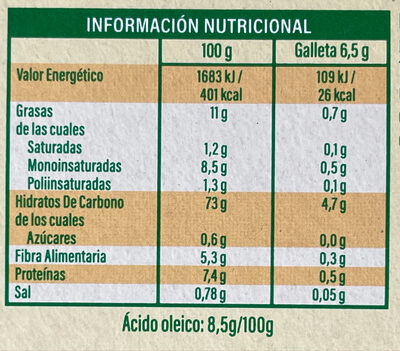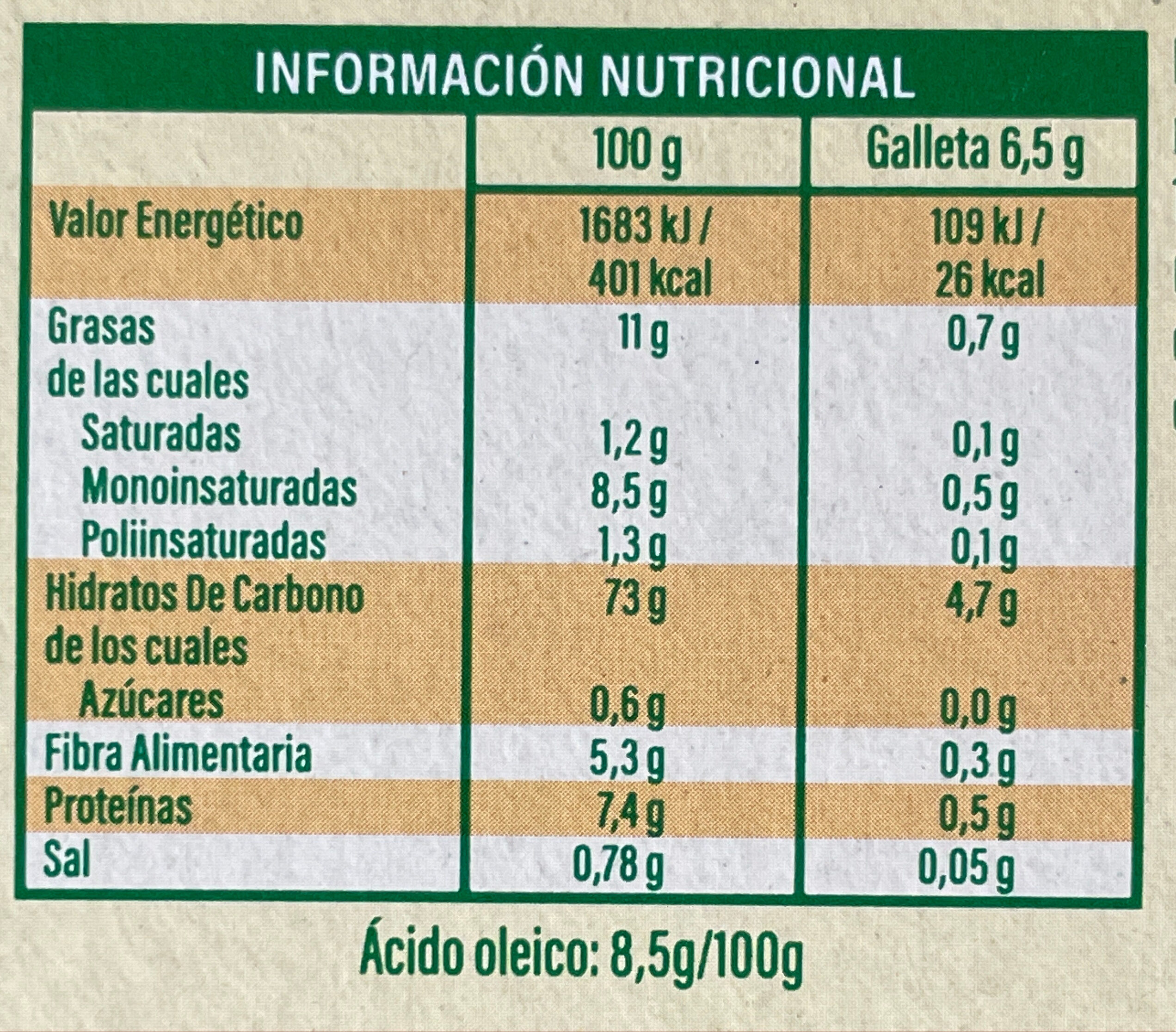Help us make food transparency the norm!
As a non-profit organization, we depend on your donations to continue informing consumers around the world about what they eat.
The food revolution starts with you!
Tostada Diet Nature - Gullón - 400 g
Tostada Diet Nature - Gullón - 400 g
This product page is not complete. You can help to complete it by editing it and adding more data from the photos we have, or by taking more photos using the app for Android or iPhone/iPad. Thank you!
×
Barra-kodea: 8410376047509 (EAN / EAN-13)
Izen arrunta: Galleta tostada sin azucares anadidos con edulcorante
Kopurua: 400 g
Ontziratzea: es:A FSC www.fsc.org MIXTO Embalaje | Apoyando la selvicultura responsable FSC C153037 RECICLA Al Azul Este envase está certificado FSC®, es:la vida silvestre y el medio ambiente. RECICLA Al Amarillo Ayúdanos a reciclar y deposita cada envase en su contenedor correspondiente., es:lo que significa que el cartón procede de bosques gestionados de forma responsable. En beneficio de las comunidades
Markak: Gullón
Kategoriak: en:Botanas, en:Desayunos, en:Galletas, en:Galletas y pasteles, en:Snacks dulces
Etiketak, ziurtagiriak, sariak:
en:Vegetarian, Source of fibre, en:Vegan, en:FSC, en:FSC Mix, en:Green Dot, High fibres, No added sugar, Nutriscore, Nutriscore B, es:Recicla amarillo, es:Recicla azul



Traceability code: FSC-C153037
Link to the product page on the official site of the producer: https://gullon.es/producto/tostada-sin-a...
Dendak: Consum
Saltzen diren herrialdeak: Espainia
Matching with your preferences
Health
Osagaiak
-
28 ingredients
Gaztelania: (ES) GALLETA CON EDULCORANTE SIN AZUCARES ANADIDOS. : Harina de TRIGO 669%, edulcorante (matitol), aceite vegetal (girasol alto oleico) 10%, fibra vegeral, harina de TRIGO malteada 29%, gasificantes (carbonato ácido de sodio, carbonato ácido de amonio), sal, aroma, emulgente (lecitina de SOJA), antioxidante (METABISULFITO SÓdico). Puede contener trazas de leche. Contiene azúcares naturalmente presentes. Fuente de fibra. Un consumo excesivo puede producir efectos laxantes. Almacenar en lugar fresco y seco. Proteger de los rayos solares. Una vez abierto, mantener en las mismas condiciones y cerrar despúes de cada usO. Consumir preferentemente antes del / Lote: ver lateral del enwase. Gullón te recomienda seguir una alimentación variada y equilibrada en el marco de un estilo de vida saludable. cUROP N VE EGETARIAN LABEL.EY oINO VEGANO G deAlergenoak: en:Gluten, en:Soybeans, es:metabisulfitoAztarnak: en:Milk
Food processing
-
Ultra processed foods
Elements that indicate the product is in the 4 - Ultra prozesatutako elikagaiak eta edariak group:
- Gehigarria: E322
- Osagaia: Emulsifier
- Osagaia: Flavouring
- Osagaia: Sweetener
Food products are classified into 4 groups according to their degree of processing:
- Prozesatu gabeko edo ahalik eta gutxien prozesatutako elikagaiak
- Sukaldaritzako osagaiak prozesatu
- Prozesatutako jakiak
- Ultra processed foods
The determination of the group is based on the category of the product and on the ingredients it contains.
Gehigarriak
-
E223
Sodium metabisulfite: Sodium metabisulfite or sodium pyrosulfite -IUPAC spelling; Br. E. sodium metabisulphite or sodium pyrosulphite- is an inorganic compound of chemical formula Na2S2O5. The substance is sometimes referred to as disodium metabisulfite. It is used as a disinfectant, antioxidant, and preservative agent.Source: Wikipedia (Ingeles)
-
E322
Lecithin: Lecithin -UK: , US: , from the Greek lekithos, "egg yolk"- is a generic term to designate any group of yellow-brownish fatty substances occurring in animal and plant tissues, which are amphiphilic – they attract both water and fatty substances -and so are both hydrophilic and lipophilic-, and are used for smoothing food textures, dissolving powders -emulsifying-, homogenizing liquid mixtures, and repelling sticking materials.Lecithins are mixtures of glycerophospholipids including phosphatidylcholine, phosphatidylethanolamine, phosphatidylinositol, phosphatidylserine, and phosphatidic acid.Lecithin was first isolated in 1845 by the French chemist and pharmacist Theodore Gobley. In 1850, he named the phosphatidylcholine lécithine. Gobley originally isolated lecithin from egg yolk—λέκιθος lekithos is "egg yolk" in Ancient Greek—and established the complete chemical formula of phosphatidylcholine in 1874; in between, he had demonstrated the presence of lecithin in a variety of biological matters, including venous blood, in human lungs, bile, human brain tissue, fish eggs, fish roe, and chicken and sheep brain. Lecithin can easily be extracted chemically using solvents such as hexane, ethanol, acetone, petroleum ether, benzene, etc., or extraction can be done mechanically. It is usually available from sources such as soybeans, eggs, milk, marine sources, rapeseed, cottonseed, and sunflower. It has low solubility in water, but is an excellent emulsifier. In aqueous solution, its phospholipids can form either liposomes, bilayer sheets, micelles, or lamellar structures, depending on hydration and temperature. This results in a type of surfactant that usually is classified as amphipathic. Lecithin is sold as a food additive and dietary supplement. In cooking, it is sometimes used as an emulsifier and to prevent sticking, for example in nonstick cooking spray.Source: Wikipedia (Ingeles)
-
E322i - Lezitina
Lecithin: Lecithin -UK: , US: , from the Greek lekithos, "egg yolk"- is a generic term to designate any group of yellow-brownish fatty substances occurring in animal and plant tissues, which are amphiphilic – they attract both water and fatty substances -and so are both hydrophilic and lipophilic-, and are used for smoothing food textures, dissolving powders -emulsifying-, homogenizing liquid mixtures, and repelling sticking materials.Lecithins are mixtures of glycerophospholipids including phosphatidylcholine, phosphatidylethanolamine, phosphatidylinositol, phosphatidylserine, and phosphatidic acid.Lecithin was first isolated in 1845 by the French chemist and pharmacist Theodore Gobley. In 1850, he named the phosphatidylcholine lécithine. Gobley originally isolated lecithin from egg yolk—λέκιθος lekithos is "egg yolk" in Ancient Greek—and established the complete chemical formula of phosphatidylcholine in 1874; in between, he had demonstrated the presence of lecithin in a variety of biological matters, including venous blood, in human lungs, bile, human brain tissue, fish eggs, fish roe, and chicken and sheep brain. Lecithin can easily be extracted chemically using solvents such as hexane, ethanol, acetone, petroleum ether, benzene, etc., or extraction can be done mechanically. It is usually available from sources such as soybeans, eggs, milk, marine sources, rapeseed, cottonseed, and sunflower. It has low solubility in water, but is an excellent emulsifier. In aqueous solution, its phospholipids can form either liposomes, bilayer sheets, micelles, or lamellar structures, depending on hydration and temperature. This results in a type of surfactant that usually is classified as amphipathic. Lecithin is sold as a food additive and dietary supplement. In cooking, it is sometimes used as an emulsifier and to prevent sticking, for example in nonstick cooking spray.Source: Wikipedia (Ingeles)
-
E500
Sodium carbonate: Sodium carbonate, Na2CO3, -also known as washing soda, soda ash and soda crystals, and in the monohydrate form as crystal carbonate- is the water-soluble sodium salt of carbonic acid. It most commonly occurs as a crystalline decahydrate, which readily effloresces to form a white powder, the monohydrate. Pure sodium carbonate is a white, odorless powder that is hygroscopic -absorbs moisture from the air-. It has a strongly alkaline taste, and forms a moderately basic solution in water. Sodium carbonate is well known domestically for its everyday use as a water softener. Historically it was extracted from the ashes of plants growing in sodium-rich soils, such as vegetation from the Middle East, kelp from Scotland and seaweed from Spain. Because the ashes of these sodium-rich plants were noticeably different from ashes of timber -used to create potash-, they became known as "soda ash". It is synthetically produced in large quantities from salt -sodium chloride- and limestone by a method known as the Solvay process. The manufacture of glass is one of the most important uses of sodium carbonate. Sodium carbonate acts as a flux for silica, lowering the melting point of the mixture to something achievable without special materials. This "soda glass" is mildly water-soluble, so some calcium carbonate is added to the melt mixture to make the glass produced insoluble. This type of glass is known as soda lime glass: "soda" for the sodium carbonate and "lime" for the calcium carbonate. Soda lime glass has been the most common form of glass for centuries. Sodium carbonate is also used as a relatively strong base in various settings. For example, it is used as a pH regulator to maintain stable alkaline conditions necessary for the action of the majority of photographic film developing agents. It acts as an alkali because when dissolved in water, it dissociates into the weak acid: carbonic acid and the strong alkali: sodium hydroxide. This gives sodium carbonate in solution the ability to attack metals such as aluminium with the release of hydrogen gas.It is a common additive in swimming pools used to raise the pH which can be lowered by chlorine tablets and other additives which contain acids. In cooking, it is sometimes used in place of sodium hydroxide for lyeing, especially with German pretzels and lye rolls. These dishes are treated with a solution of an alkaline substance to change the pH of the surface of the food and improve browning. In taxidermy, sodium carbonate added to boiling water will remove flesh from the bones of animal carcasses for trophy mounting or educational display. In chemistry, it is often used as an electrolyte. Electrolytes are usually salt-based, and sodium carbonate acts as a very good conductor in the process of electrolysis. In addition, unlike chloride ions, which form chlorine gas, carbonate ions are not corrosive to the anodes. It is also used as a primary standard for acid-base titrations because it is solid and air-stable, making it easy to weigh accurately.Source: Wikipedia (Ingeles)
-
E500ii - Sodio hidrogenokarbonato
Sodium carbonate: Sodium carbonate, Na2CO3, -also known as washing soda, soda ash and soda crystals, and in the monohydrate form as crystal carbonate- is the water-soluble sodium salt of carbonic acid. It most commonly occurs as a crystalline decahydrate, which readily effloresces to form a white powder, the monohydrate. Pure sodium carbonate is a white, odorless powder that is hygroscopic -absorbs moisture from the air-. It has a strongly alkaline taste, and forms a moderately basic solution in water. Sodium carbonate is well known domestically for its everyday use as a water softener. Historically it was extracted from the ashes of plants growing in sodium-rich soils, such as vegetation from the Middle East, kelp from Scotland and seaweed from Spain. Because the ashes of these sodium-rich plants were noticeably different from ashes of timber -used to create potash-, they became known as "soda ash". It is synthetically produced in large quantities from salt -sodium chloride- and limestone by a method known as the Solvay process. The manufacture of glass is one of the most important uses of sodium carbonate. Sodium carbonate acts as a flux for silica, lowering the melting point of the mixture to something achievable without special materials. This "soda glass" is mildly water-soluble, so some calcium carbonate is added to the melt mixture to make the glass produced insoluble. This type of glass is known as soda lime glass: "soda" for the sodium carbonate and "lime" for the calcium carbonate. Soda lime glass has been the most common form of glass for centuries. Sodium carbonate is also used as a relatively strong base in various settings. For example, it is used as a pH regulator to maintain stable alkaline conditions necessary for the action of the majority of photographic film developing agents. It acts as an alkali because when dissolved in water, it dissociates into the weak acid: carbonic acid and the strong alkali: sodium hydroxide. This gives sodium carbonate in solution the ability to attack metals such as aluminium with the release of hydrogen gas.It is a common additive in swimming pools used to raise the pH which can be lowered by chlorine tablets and other additives which contain acids. In cooking, it is sometimes used in place of sodium hydroxide for lyeing, especially with German pretzels and lye rolls. These dishes are treated with a solution of an alkaline substance to change the pH of the surface of the food and improve browning. In taxidermy, sodium carbonate added to boiling water will remove flesh from the bones of animal carcasses for trophy mounting or educational display. In chemistry, it is often used as an electrolyte. Electrolytes are usually salt-based, and sodium carbonate acts as a very good conductor in the process of electrolysis. In addition, unlike chloride ions, which form chlorine gas, carbonate ions are not corrosive to the anodes. It is also used as a primary standard for acid-base titrations because it is solid and air-stable, making it easy to weigh accurately.Source: Wikipedia (Ingeles)
-
E503
Ammonium carbonate: Ammonium carbonate is a salt with the chemical formula -NH4-2CO3. Since it readily degrades to gaseous ammonia and carbon dioxide upon heating, it is used as a leavening agent and also as smelling salt. It is also known as baker's ammonia and was a predecessor to the more modern leavening agents baking soda and baking powder. It is a component of what was formerly known as sal volatile and salt of hartshorn.Source: Wikipedia (Ingeles)
-
E503ii
Ammonium carbonate: Ammonium carbonate is a salt with the chemical formula -NH4-2CO3. Since it readily degrades to gaseous ammonia and carbon dioxide upon heating, it is used as a leavening agent and also as smelling salt. It is also known as baker's ammonia and was a predecessor to the more modern leavening agents baking soda and baking powder. It is a component of what was formerly known as sal volatile and salt of hartshorn.Source: Wikipedia (Ingeles)
Ingredients analysis
-
en:Palm oil content unknown
Unrecognized ingredients: es:galleta-con-edulcorante-sin-azucares-anadidos, es:matitol, es:fibra-vegeral, es:contiene-azucares-naturalmente-presentes, es:un-consumo-excesivo-puede-producir-efectos-laxantes, es:almacenar-en-lugar-fresco-y-seco, es:proteger-de-los-rayos-solares, es:una-vez-abierto, es:mantener-en-las-mismas-condiciones-y-cerrar-despues-de-cada-uso, es:consumir-preferentemente-antes-del, es:lote, es:ver-lateral-del-enwase, es:gullon-te-recomienda-seguir-una-alimentacion-variada-y-equilibrada-en-el-marco-de-un-estilo-de-vida-saludable, es:curop-n-ve-egetarian-label-ey-oino-g-deSome ingredients could not be recognized.
We need your help!
You can help us recognize more ingredients and better analyze the list of ingredients for this product and others:
- Edit this product page to correct spelling mistakes in the ingredients list, and/or to remove ingredients in other languages and sentences that are not related to the ingredients.
- Add new entries, synonyms or translations to our multilingual lists of ingredients, ingredient processing methods, and labels.
If you would like to help, join the #ingredients channel on our Slack discussion space and/or learn about ingredients analysis on our wiki. Thank you!
-
en:Vegan
No non-vegan ingredients
Unrecognized ingredients: es:galleta-con-edulcorante-sin-azucares-anadidos, es:matitol, es:fibra-vegeral, es:contiene-azucares-naturalmente-presentes, es:un-consumo-excesivo-puede-producir-efectos-laxantes, es:almacenar-en-lugar-fresco-y-seco, es:proteger-de-los-rayos-solares, es:una-vez-abierto, es:mantener-en-las-mismas-condiciones-y-cerrar-despues-de-cada-uso, es:consumir-preferentemente-antes-del, es:lote, es:ver-lateral-del-enwase, es:gullon-te-recomienda-seguir-una-alimentacion-variada-y-equilibrada-en-el-marco-de-un-estilo-de-vida-saludableSome ingredients could not be recognized.
We need your help!
You can help us recognize more ingredients and better analyze the list of ingredients for this product and others:
- Edit this product page to correct spelling mistakes in the ingredients list, and/or to remove ingredients in other languages and sentences that are not related to the ingredients.
- Add new entries, synonyms or translations to our multilingual lists of ingredients, ingredient processing methods, and labels.
If you would like to help, join the #ingredients channel on our Slack discussion space and/or learn about ingredients analysis on our wiki. Thank you!
-
en:Vegetarian
No non-vegetarian ingredients detected
Unrecognized ingredients: es:galleta-con-edulcorante-sin-azucares-anadidos, es:matitol, es:fibra-vegeral, es:contiene-azucares-naturalmente-presentes, es:un-consumo-excesivo-puede-producir-efectos-laxantes, es:almacenar-en-lugar-fresco-y-seco, es:proteger-de-los-rayos-solares, es:una-vez-abierto, es:mantener-en-las-mismas-condiciones-y-cerrar-despues-de-cada-uso, es:consumir-preferentemente-antes-del, es:lote, es:ver-lateral-del-enwase, es:gullon-te-recomienda-seguir-una-alimentacion-variada-y-equilibrada-en-el-marco-de-un-estilo-de-vida-saludableSome ingredients could not be recognized.
We need your help!
You can help us recognize more ingredients and better analyze the list of ingredients for this product and others:
- Edit this product page to correct spelling mistakes in the ingredients list, and/or to remove ingredients in other languages and sentences that are not related to the ingredients.
- Add new entries, synonyms or translations to our multilingual lists of ingredients, ingredient processing methods, and labels.
If you would like to help, join the #ingredients channel on our Slack discussion space and/or learn about ingredients analysis on our wiki. Thank you!
-
Details of the analysis of the ingredients
We need your help!
Some ingredients could not be recognized.
We need your help!
You can help us recognize more ingredients and better analyze the list of ingredients for this product and others:
- Edit this product page to correct spelling mistakes in the ingredients list, and/or to remove ingredients in other languages and sentences that are not related to the ingredients.
- Add new entries, synonyms or translations to our multilingual lists of ingredients, ingredient processing methods, and labels.
If you would like to help, join the #ingredients channel on our Slack discussion space and/or learn about ingredients analysis on our wiki. Thank you!
es: GALLETA CON EDULCORANTE SIN AZUCARES ANADIDOS (Harina de TRIGO 669%), edulcorante (matitol), aceite vegetal 10% (girasol alto oleico), fibra vegeral, harina de TRIGO malteada 29%, gasificantes (carbonato ácido de sodio, carbonato ácido de amonio), sal, aroma, emulgente (lecitina de SOJA), antioxidante (METABISULFITO SÓdico), Contiene azúcares naturalmente presentes, Un consumo excesivo puede producir efectos laxantes, Almacenar en lugar fresco y seco, Proteger de los rayos solares, Una vez abierto, mantener en las mismas condiciones y cerrar despúes de cada usO, Consumir preferentemente antes del, Lote (ver lateral del enwase, Gullón te recomienda seguir una alimentación variada y equilibrada en el marco de un estilo de vida saludable, cUROP N VE EGETARIAN LABEL.EY oINO G de)- GALLETA CON EDULCORANTE SIN AZUCARES ANADIDOS -> es:galleta-con-edulcorante-sin-azucares-anadidos
- Harina de TRIGO -> en:wheat-flour - vegan: yes - vegetarian: yes - ciqual_proxy_food_code: 9410 - percent: 669
- edulcorante -> en:sweetener
- matitol -> es:matitol
- aceite vegetal -> en:vegetable-oil - vegan: yes - vegetarian: yes - from_palm_oil: maybe - percent: 10
- girasol alto oleico -> en:high-oleic-sunflower - vegan: yes - vegetarian: yes - from_palm_oil: no - ciqual_food_code: 17440
- fibra vegeral -> es:fibra-vegeral
- harina de TRIGO malteada -> en:malted-wheat-flour - vegan: yes - vegetarian: yes - ciqual_proxy_food_code: 9410 - percent: 29
- gasificantes -> en:raising-agent
- carbonato ácido de sodio -> en:e500ii - vegan: yes - vegetarian: yes
- carbonato ácido de amonio -> en:e503ii - vegan: yes - vegetarian: yes
- sal -> en:salt - vegan: yes - vegetarian: yes - ciqual_food_code: 11058
- aroma -> en:flavouring - vegan: maybe - vegetarian: maybe
- emulgente -> en:emulsifier
- lecitina de SOJA -> en:soya-lecithin - vegan: yes - vegetarian: yes - ciqual_food_code: 42200
- antioxidante -> en:antioxidant
- METABISULFITO SÓdico -> en:e223 - vegan: yes - vegetarian: yes
- Contiene azúcares naturalmente presentes -> es:contiene-azucares-naturalmente-presentes
- Un consumo excesivo puede producir efectos laxantes -> es:un-consumo-excesivo-puede-producir-efectos-laxantes
- Almacenar en lugar fresco y seco -> es:almacenar-en-lugar-fresco-y-seco
- Proteger de los rayos solares -> es:proteger-de-los-rayos-solares
- Una vez abierto -> es:una-vez-abierto
- mantener en las mismas condiciones y cerrar despúes de cada usO -> es:mantener-en-las-mismas-condiciones-y-cerrar-despues-de-cada-uso
- Consumir preferentemente antes del -> es:consumir-preferentemente-antes-del
- Lote -> es:lote
- ver lateral del enwase -> es:ver-lateral-del-enwase
- Gullón te recomienda seguir una alimentación variada y equilibrada en el marco de un estilo de vida saludable -> es:gullon-te-recomienda-seguir-una-alimentacion-variada-y-equilibrada-en-el-marco-de-un-estilo-de-vida-saludable
- cUROP N VE EGETARIAN LABEL.EY oINO G de -> es:curop-n-ve-egetarian-label-ey-oino-g-de - labels: en:vegan - vegan: en:yes - vegetarian: en:yes
Elikadura
-
Good nutritional quality
⚠ ️Warning: the amount of fruits, vegetables and nuts is not specified on the label, it was estimated from the list of ingredients: 0This product is not considered a beverage for the calculation of the Nutri-Score.
Positive points: 9
- Proteinak: 4 / 5 (balioa: 7.4, rounded value: 7.4)
- Fiber: 5 / 5 (balioa: 5.3, rounded value: 5.3)
- Fruits, vegetables, nuts, and colza/walnut/olive oils: 0 / 5 (balioa: 0, rounded value: 0)
Negative points: 9
- Energia: 5 / 10 (balioa: 1683, rounded value: 1683)
- Azukreak: 0 / 10 (balioa: 0.6, rounded value: 0.6)
- Gantz saturatua: 1 / 10 (balioa: 1.2, rounded value: 1.2)
- Sodioa: 3 / 10 (balioa: 312, rounded value: 312)
The points for proteins are counted because the negative points are less than 11.
Nutritional score: (9 - 9)
Nutri-Score:
-
Nutrient levels
-
Koipe in moderate quantity (11%)
What you need to know- A high consumption of fat, especially saturated fats, can raise cholesterol, which increases the risk of heart diseases.
Recommendation: Limit the consumption of fat and saturated fat- Choose products with lower fat and saturated fat content.
-
Gantz-azido ase in low quantity (1.2%)
What you need to know- A high consumption of fat, especially saturated fats, can raise cholesterol, which increases the risk of heart diseases.
Recommendation: Limit the consumption of fat and saturated fat- Choose products with lower fat and saturated fat content.
-
Azukre in low quantity (0.6%)
What you need to know- A high consumption of sugar can cause weight gain and tooth decay. It also augments the risk of type 2 diabetes and cardio-vascular diseases.
Recommendation: Limit the consumption of sugar and sugary drinks- Sugary drinks (such as sodas, fruit beverages, and fruit juices and nectars) should be limited as much as possible (no more than 1 glass a day).
- Choose products with lower sugar content and reduce the consumption of products with added sugars.
-
Gatz arrunt in moderate quantity (0.78%)
What you need to know- A high consumption of salt (or sodium) can cause raised blood pressure, which can increase the risk of heart disease and stroke.
- Many people who have high blood pressure do not know it, as there are often no symptoms.
- Most people consume too much salt (on average 9 to 12 grams per day), around twice the recommended maximum level of intake.
Recommendation: Limit the consumption of salt and salted food- Reduce the quantity of salt used when cooking, and don't salt again at the table.
- Limit the consumption of salty snacks and choose products with lower salt content.
-
-
Nutrition facts
Nutrition facts As sold
for 100 g / 100 mlAs sold
per serving (6,5 g)Compared to: en:desayunos Energia 1.683 kj
(401 kcal)109 kj
(26 kcal)-% 2 Koipe 11 g 0,715 g -% 17 Gantz-azido ase 1,2 g 0,078 g -% 61 Gantz-azido monoasegabe 8,5 g 0,552 g Polyunsaturated fat 1,3 g 0,084 g Azido oleiko 8,5 g 0,552 g Carbohydrates 73 g 4,75 g +% 17 Azukre 0,6 g 0,039 g -% 98 Fiber 5,3 g 0,344 g +% 22 Proteina 7,4 g 0,481 g +% 20 Gatz arrunt 0,78 g 0,051 g +% 145 Fruits‚ vegetables‚ nuts and rapeseed‚ walnut and olive oils (estimate from ingredients list analysis) 0 % 0 %
Ingurumena
-
Eco-Score not computed - Unknown environmental impact
We could not compute the Eco-Score of this product as it is missing some data, could you help complete it?Could you add a precise product category so that we can compute the Eco-Score? Add a category
Ontziratzea
-
Packaging with a low impact
-
Packaging parts
1 x Box (Cardboard)
-
Bilgarriaren materialak
Material % Bilgarriaren pisua Bilgarriaren pisua produktuaren 100g-ko Paper or cardboard
-
Transportation
-
Origins of ingredients
Missing origins of ingredients information
⚠ ️ The origins of the ingredients of this product are not indicated.
If they are indicated on the packaging, you can modify the product sheet and add them.
If you are the manufacturer of this product, you can send us the information with our free platform for producers.Add the origins of ingredients for this product Add the origins of ingredients for this product
Report a problem
-
Incomplete or incorrect information?
Category, labels, ingredients, allergens, nutritional information, photos etc.
If the information does not match the information on the packaging, please complete or correct it. Open Food Facts is a collaborative database, and every contribution is useful for all.
Datuen iturria
Product added on by kiliweb
Last edit of product page on by grumpf.
Produktuaren orria -gatik editatua autorotate-bot, ejmillan, emeterio, fix-salt-bot, inf, maylord, musarana, october-food-facts, openfoodfacts-contributors, packbot, roboto-app, spotter, tasja, thaialagata, vaiton, yuka.SHFRRU5wb3d0S1k0bGNJQjRoYjgwK3RNbkxEMkJuR2FPOEJPSUE9PQ, yuka.VnY0K09ZMC9wT2N0a01BeDF4bUZwL2trNVlLWVZqK1ZHc2dOSVE9PQ, yuka.WFBnT0FJUXN2dU5YdzhRWjh6Zkx3ZTUzeE1hVGRuanVMdU05SVE9PQ.












